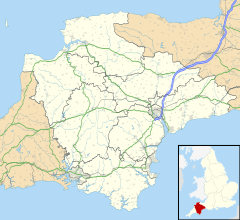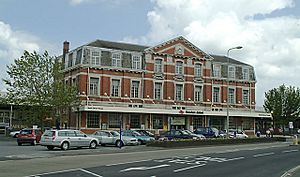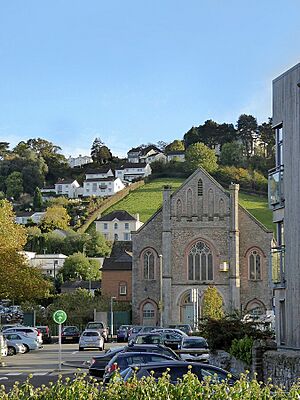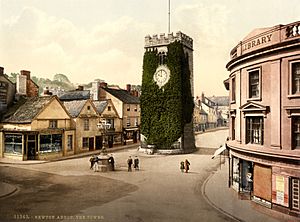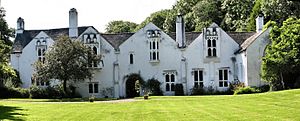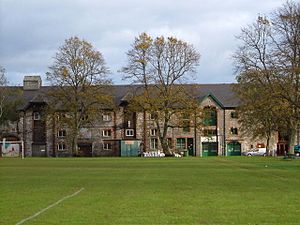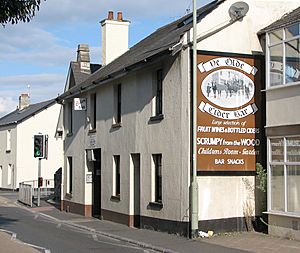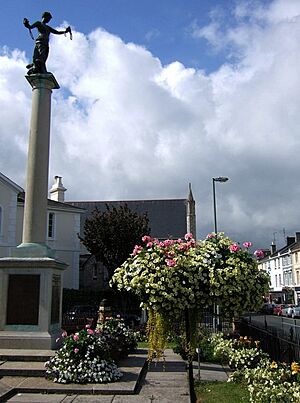Newton Abbot facts for kids
Quick facts for kids Newton Abbot |
|
|---|---|
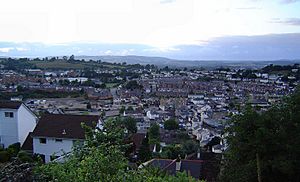 View over central Newton Abbot taken from Wolborough Hill, July 2005 |
|
 Flag |
|
| Population | 25,556 (2011) |
| OS grid reference | SX860713 |
| Civil parish |
|
| District |
|
| Shire county | |
| Region | |
| Country | England |
| Sovereign state | United Kingdom |
| Post town | NEWTON ABBOT |
| Postcode district | TQ12 |
| Dialling code | 01626 |
| Police | Devon and Cornwall |
| Fire | Devon and Somerset |
| Ambulance | South Western |
| EU Parliament | South West England |
| UK Parliament |
|
Newton Abbot is a busy market town in Devon, England. It sits by the River Teign. In 2011, about 24,000 people lived here. The town grew very fast during the Victorian era. This was because of the South Devon Railway and its train workshops.
Newton Abbot also has a horse racing track. It is the most western one in England. There is also a lovely country park called Decoy. The town is connected to two towns in Europe. It is twinned with Besigheim in Germany and Ay in France.
Contents
What's in a Name?
Newton Abbot is not in the old Domesday Book from 1086. It was first written about in the late 1100s. Back then, it was called Nova Villa, which means "new farm" in Latin. Later, in 1201, it was called Nieweton' abbatis. This means "New settlement belonging to the abbot". The land was given to Torre Abbey in 1196.
Another part of the town was called Newton Bushel. This was named after Robert Bussell, who owned that area. The two towns worked together. Their markets eventually joined up. People often just called the town "Newton". The railway later named the station Newton Abbot. This helped tell it apart from other "Newtons" on the train lines.
A Look Back in Time
Early Settlements
People lived in this area a very long time ago. Traces of Neolithic people have been found. This was at Berry's Wood Hill Fort. It was a large fort covering about 11 acres. Milber Down camp was built before 1 BC. Romans also stayed there for a short time. Roman coins have been found at the site.
Highweek Hill has remains of an old Norman castle. It is called Castle Dyke. A village grew around this castle. It was first called Teignwick. Later, it became Highweek. This name means "village on high ground". Another village grew by the River Lemon. This became part of Wolborough Manor.
Busy Markets
Newton Abbot has had a busy market for over 750 years. The first market was allowed in 1220. The "New Town of the Abbots" (from Torre Abbey) could hold a market every Wednesday. This was between 1247 and 1251. The market helped the town grow quickly. It brought good money for the Abbots.
Across the river, on the Highweek side, another market started. This one was on Tuesdays. The Bushel family owned this land. So, this area became Newton Bushel. Over the next 200 years, Newton Bushel had more yearly fairs. Mills were built, and the leather and wool trades began.
The two markets of Newton Abbot and Newton Bushel joined in 1633. It became one Wednesday market. By 1751, a smaller Saturday market was added. There were also three yearly fairs. These included a cattle fair and a cheese and onion fair. In 1826, a new market place was built. Later, a new corn exchange and market hall were finished in 1871. This building is now the Alexandra Theatre.
Wool and Leather Trades
In olden times, Devon was big in sheep farming. Many towns had their own wool and cloth businesses. Newton Abbot had woollen mills and people who worked with wool. They had fullers, dyers, spinners, weavers, and tailors. Removing wool from sheepskin was also common.
In 1724, Daniel Defoe wrote about Newton Abbot. He said it had a busy serge cloth industry. Goods were sent to Holland through Exeter. The yearly cloth fair was the busiest fair in town. Vicary's mills became a big employer. By the 1920s, over 400 men worked there. But the business closed in 1972.
The leather business was also important. Hides from sheepskin were made into leather. Tanners, shoemakers, glovers, and saddlers worked in Newton Abbot. Like the wool trade, the leather business did well for 600 years. It declined after World War II.
The Newfoundland Trade
In 1583, Humphrey Gilbert from this area landed in Newfoundland. He claimed it for England. Fishing quickly grew there. From 1600 to 1850, Newton Abbot traded a lot with the cod fisheries in Newfoundland. Every year, men from town would go to inns. They hoped to be hired for a season's work.
This trade brought many other jobs to the town. Fish hooks, knives, waterproof boots, and rope were all made here. The Rope Walk in East Street still exists. You can also find names like Newfoundland Way and St John's Street.
Ball Clay and the Stover Canal
Just 2 miles (3 km) north-west of Newton Abbot are large ball clay mines. This area is known for Britain's ball-clay industry. The clay is very pure and fine. It is used in many products. These include bricks, tyres, porcelain, medicines, and toothpaste.
Kingsteignton clay was used to make pipes around 1680. By 1700, it was shipped from Teignmouth. Famous potter Josiah Wedgwood used this clay. The clay was dug out in lumps. It was then taken by packhorse to Hackney Quay. From there, it went on barges down the Teign Estuary. Then it was put onto ships for other ports.
In the late 1700s, the ball-clay industry grew. James Templer built the Stover Canal in 1792. This helped ship clay from the Bovey Basin to Teignmouth. Coal and farm goods were also shipped. James Templer's son, George Templer, built the Haytor Granite Tramway. This tramway had rails made of granite. It connected granite quarries to the canal. This was finished by 1820. Large amounts of granite were moved for big projects. For example, the new London Bridge opened in 1825.
The canal was later extended. The industry did well until 1858. Then, cheaper granite from Cornwall took over. The Stover Canal went back to shipping ball clay. But it stopped doing so by 1939. Today, the ball-clay industry is very modern. Most clay is moved by road. It is then shipped from Teignmouth.
The Stover Canal Society was formed in 1999. Their goal is to save and fix the canal. In 2005, the canal was given to Teignbridge District Council. It is now being restored for people to enjoy.
The Railway Arrives
The South Devon railway came to Newton Abbot in 1846. This changed the town a lot. It went from a market town to an industrial place. The South Devon Railway Company opened the station on December 30, 1846. A branch line to Torquay was added in 1848. Another line to Moretonhampstead opened in 1866. This last one is now closed to passengers.
Isambard Kingdom Brunel tried out his "atmospheric railway" here. This experiment failed. But parts of his pumping house still exist. In 1876, the Great Western Railway bought the lines. They made the repair sheds much bigger. The current station was rebuilt in 1927. The large clock was a gift from the town.
In the late 1980s, the number of train platforms was cut down. Many other businesses started near the railway. These included a timber yard and metal foundries. Newton Abbot power station was built next to the railway. The town's population grew a lot. It went from 1,623 people in 1801 to 12,518 by 1901. New streets were built for workers. Nice houses appeared for richer people.
Modern Times
Newton Abbot was affected by the World Wars. Over 250 men from the town died in these wars. They are remembered on the town's war memorial. The town was bombed twice during World War II. A total of 21 people died. There was a big flood in 1979. The River Lemon overflowed after heavy rain.
Newton Abbot also had a stock-car track. It was at the racecourse. It was popular for nearly 30 years. A new community hospital opened in 2009.
The Flag of Newton Abbot was adopted in 2009. It shows St Leonard's Tower. This is in the middle of a changed flag of Devon. The green on the flag means the moors. Black is for the granite. White is for the clay. The cross on the flag shows a main crossroads in town. These routes go to places like Exeter, Dartmoor, Plymouth, and Torquay.
How the Town is Run
Newton Abbot has three levels of local government. These are the town, district, and county levels. Newton Abbot Town Council, Teignbridge District Council, and Devon County Council all help run the town.
The town council used to be in the old town hall. Now, it is at Newton's Place. This building was once St Leonard's Church. It was built in 1835. The old church was turned into a museum and community center. The first council meeting there was in June 2021. Teignbridge District Council also has its offices in town. They are at Forde House.
Newton Abbot was part of the Wolborough parish. A local government group was set up in 1864. It was called the Wolborough Local Board. In 1894, these boards became urban district councils. The Wolborough board asked to change its name to Newton Abbot. This was because Newton Abbot was the main town. So, the Newton Abbot Urban District Council was formed.
In 1901, the urban district grew. It included Highweek and the Milber area. From 1901 to 1974, the Newton Abbot Urban District covered three parishes. These were Wolborough, Highweek, and Milber. In 1974, the Newton Abbot Urban District was ended. The area became part of the new Teignbridge district. A new parish called Newton Abbot was created. Its council became Newton Abbot Town Council.
Newton Abbot is the main town in the Newton Abbot parliamentary area. This area chooses a Member of Parliament (MP). Newton Abbot also has two seats on Devon County Council. These are for Newton Abbot North and Newton Abbot South.
Learning in Newton Abbot
Newton Abbot has several schools for different ages.
- Coombeshead Academy is a big school for students aged 11 to 18. It focuses on media and arts.
- Newton Abbot College is another large school for ages 11 to 18. It used to be Knowles Hill School. It specializes in technology.
- South Devon UTC is a special college for students aged 14 to 19. It opened in 2015.
- Stover School is a private school.
There are also many primary schools. These include St Joseph's Roman Catholic Primary, Highweek Community Primary, Decoy Primary, Bearnes Primary, Canada Hill Primary, Wolborough C of E Primary, Bradley Barton Primary, Haytor View Primary, and All Saints Marsh CofE Academy.
Town Areas
The town of Newton Abbot has grown over time. It now includes areas like Highweek (to the north-west) and Wolborough (to the south). Other parts of the town are Abbotsbury, Aller Park, Broadlands, Buckland, Knowles Hill, Milber, Mile End, and Newtake.
Famous Places to See
Alexandra Theatre
The Alexandra Theatre was built in 1871. It was first meant to be a corn exchange. But before it was finished, it was decided to use it as a community hall. In 1883, it was upgraded. A stage and dressing rooms were added. Many changes happened over the years. In 1996, it became a two-screen cinema.
St Leonard's Tower
In the town center, you can see the old tower of St Leonard. It is all that is left of a medieval chapel. The chapel was built in 1220. The main part of the chapel was taken down in 1836. This was to help with traffic. Next to the tower is a plaque. It marks where William III, Prince of Orange's first declaration was read in 1688. He came to England to become king.
The tower often flies the Union Flag. It also flies the Flag of Newton Abbot.
Forde House
Forde House is in the south-east of the town. The house you see today was built in 1610. It was built by Richard Reynell and his wife Lucy. It has an E-shape floor plan. This was probably to honor Queen Elizabeth I. The grounds used to be very large. They included Decoy, where wild birds were caught for food.
In 1625, King Charles I stayed here. He was on his way to inspect the fleet at Plymouth. Oliver Cromwell also stayed at Forde House in 1646. William of Orange stayed here in 1688. He was on his way to his coronation in London. The house stayed with the Courtenay family until 1762.
Teignbridge District Council bought the house in 1978. They still own it. It has been fixed up. Now it is used for offices, meetings, and weddings.
Bradley Manor
On the other side of Newton Abbot is Bradley Manor. This is a property owned by the National Trust. It is a 15th-century manor house. It has a great hall with the royal coat of arms of Elizabeth I. Nearby is Bakers Park.
The Great Western Railway named a steam train after the manor.
Passmore Edwards Public Library
John Passmore Edwards wanted a hospital built in Newton Abbot. It was to honor his mother. But the town already had a hospital. So, he decided on a public library. It opened in 1904. The building is one of the most impressive in Newton Abbot. It was designed by Silvanus Trevail. It used to have a Science, Art and Technical School. Passmore Edwards gave £2,500. The rest was paid by the County Council and public donations. It was renovated in 2010–2012. It was renamed the Passmore Edwards Centre.
Old Almshouses
Newton Abbot has several old almshouses. These were homes for poor people.
- Gilberd's in Exeter Road were built in 1538. They were for people with leprosy.
- In 1576, Robert Hayman built houses for the poor in East Street. These were rebuilt in 1840.
- Reynell's almshouses were built in 1640. They were for four widows of clergy. They were rebuilt in 1845.
- Mackrell's almshouses in Wolborough Street were built in 1874. Mackrell was from Newton Abbot. He made his money as a chemist.
The Workhouse
The first poorhouse in Newton Abbot was in East Street. The cellar of the Devon Arms was used for picking oakum. This was a hard job for poor people. They untwisted old rope. This oakum was used to seal wooden boats. Newton Bushel also had its own poorhouse.
A new workhouse was built in 1839. It was for poor people from nearby areas. Over time, the workhouse became more like a hospital. It cared for the sick, weak, and old poor.
Tucker's Maltings
Near the railway station is the old Tucker's Maltings. For a long time, it was the only traditional malthouse in the UK open to the public. It made malt for over 30 breweries. It made enough to brew 15 million litres of beer each year. It closed as a malthouse in 2018. Now, it has other businesses. These include The Maltings Taphouse, a craft beer bar.
Cider Bar
Ye Olde Cider Bar in East Street is said to be one of only two cider houses left in the UK. It only sells cider, perry, and country wines. The inside of the bar has not changed much.
Newton Abbot Town & GWR Museum
The museum moved in 2019. It is now in the Newton's Place community center. It shows the history of Newton Abbot. It also shows the history of the Great Western Railway.
Newton Abbot War Memorial
In 1922, a war memorial was designed for the town. It was to remember the young men who died in the war. It was unveiled and dedicated on July 23, 1922.
Getting Around
Railway Travel
Newton Abbot railway station is at the east end of Queen Street. It has trains for both local and long-distance travel. You can go to places like London, the Midlands, and Scotland.
Great Western Railway runs trains to London Paddington. These run at least once an hour. Local trains run from Exmouth and Exeter to Paignton.
CrossCountry trains go through Birmingham. They go to places like Manchester, the north-east of England, and Scotland.
Bus Services
The main bus company is Stagecoach South West. They have many regular bus services. You can go from Newton Abbot to places like Exeter, Torquay, Paignton, and Teignmouth. Another local company, Country Bus, also runs many services from the town.
Roads
Newton Abbot is connected to the A380 dual carriageway. This road leads to the M5 motorway through the A38.
Other main roads connected to the town are:
- The A381 goes from Teignmouth to Salcombe, passing through Newton Abbot.
- The A382 starts at Newton Abbot. It goes through Bovey Tracey.
- The A383 goes from Newton Abbot through Bickington.
Media and News
Local TV news comes from BBC South West and ITV West Country. You can get TV signals from Beacon Hill.
Local radio stations include BBC Radio Devon (104.3 FM) and Heart West (96.4 FM). There is also Greatest Hits Radio Devon (105.5 FM) and Radio Exe (107.3 FM).
The local newspaper is the Mid-Devon Advertiser. It comes out every Thursday.
Sports and Fun
Newton Abbot has two local non-League football clubs. These are Buckland Athletic F.C. and Newton Abbot Spurs A.F.C.. The main office for the Devon County Football Association is in the town.
Newton Abbot's South Devon Cricket Club started in 1851. They also play at the Recreation Ground.
The town has a long-standing rugby union club. It is called Newton Abbot RFC. It started in 1873. They play home games in nearby Kingsteignton.
There were also two greyhound racing tracks. The Newton Abbot Greyhound Track was open from 1974 to 2005. A short-lived track was also on the Recreation Ground.
Famous People from Newton Abbot
Many interesting people have connections to Newton Abbot:
- John Angel, a sculptor, was born here in 1881.
- Sir Samuel White Baker, an explorer and writer, lived here.
- Norah Baring, a movie actress, studied art here.
- William Knox D'Arcy, who helped start the oil industry in Persia, was born here in 1849.
- Colonel Percy Fawcett, a famous explorer of South America, went to school here.
- Robert Hayman, a poet, was born in Wolborough, which is now part of Newton Abbot.
- Oliver Heaviside, a physicist, lived here for many years.
- Jon Lee (actor), a singer and actor, had his early education here.
- John Lethbridge invented a diving machine in 1715.
- Frank Matcham, a theater architect, was born here in 1854.
- Rupert Neve, an audio electronics engineer, was born here in 1926.
- Sergio Pizzorno, a guitarist for the band Kasabian, was born here in 1980.
- Anthea Redfern, a TV host, was born here in 1948.
- Ollie Watkins, a famous footballer for Aston Villa and England, lived here for many years.
- Ivy Williams, the first woman to become a barrister in England, was born here in 1877.
Freedom of the Town
Some people and military groups have been given the special "Freedom of the Town" honor in Newton Abbot.
Military Units
- HMS Triumph, RN: April 1, 2023.
See also
 In Spanish: Newton Abbot para niños
In Spanish: Newton Abbot para niños


